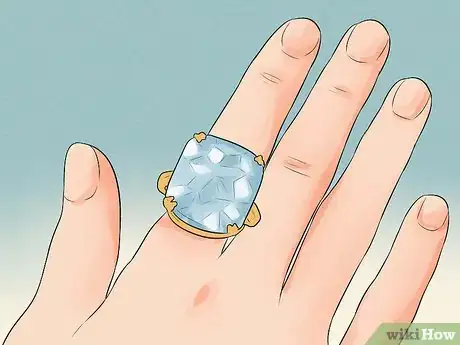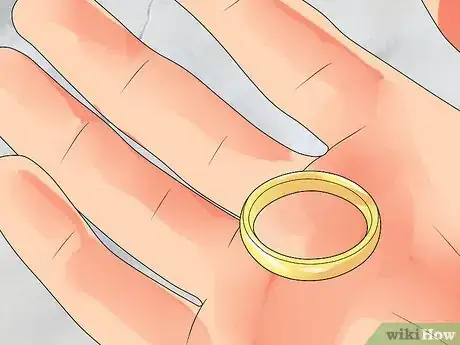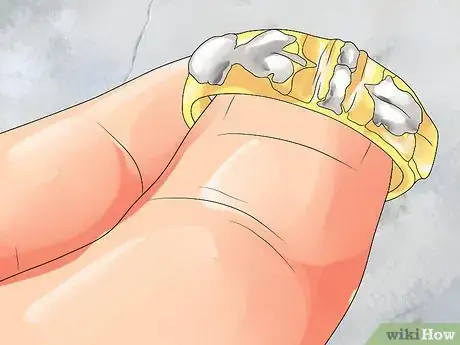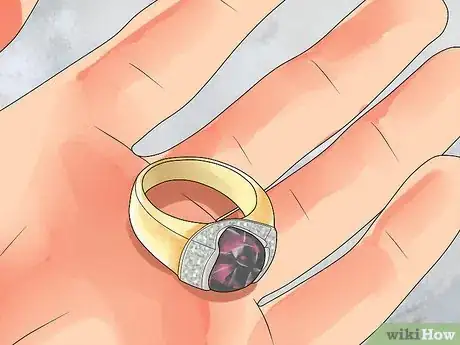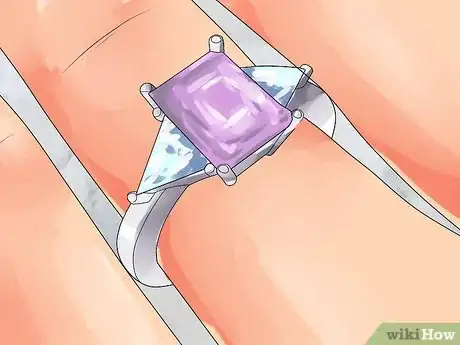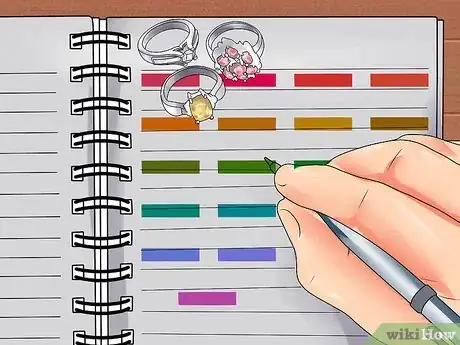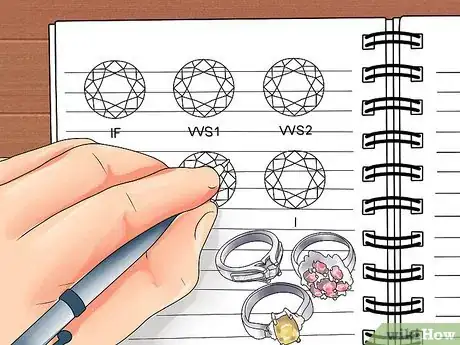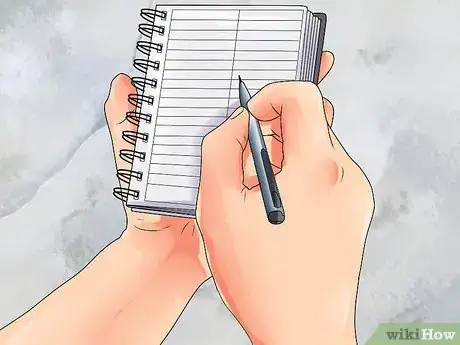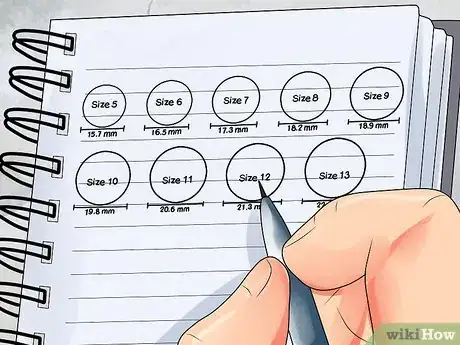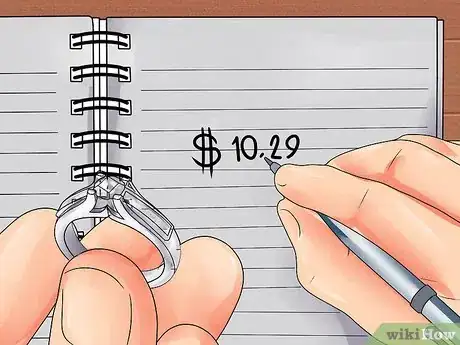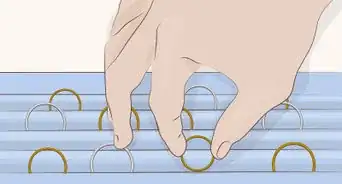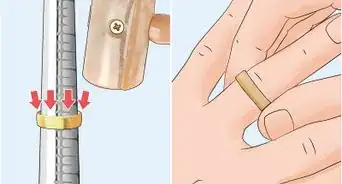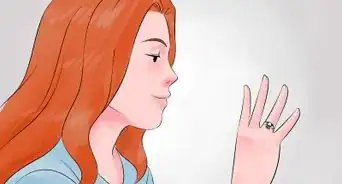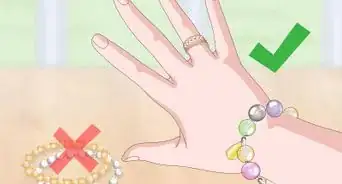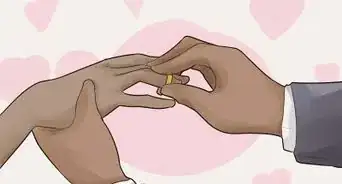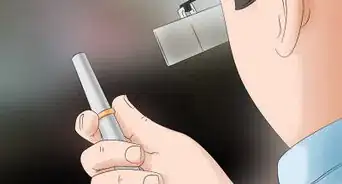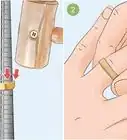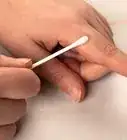This article was co-authored by Nicole Wegman. Nicole Wegman is the Founder and CEO of Ring Concierge, a New York City-based fine jewelry brand. Specializing in engagement ring and wedding band trends, Ring Concierge creates a luxury experience catered towards millennials. Ring Concierge offers engagement rings along with earrings, necklaces, bracelets, and anklets. Nicole's work and Ring Concierge have been featured in Vogue, Glamour, Who What Wear, Martha Stewart Weddings, Brides, and Cosmopolitan. Nicole is a GIA (Gemological Institute of America) Accredited Jewelry Professional and holds a BS in Fiber Science and Apparel Design from Cornell University.
There are 7 references cited in this article, which can be found at the bottom of the page.
This article has been viewed 53,323 times.
Rings for all occasions come in all shapes and sizes, and knowing where to start when describing a specific ring can be difficult if you aren't familiar with the different options. You will need to describe both the band and the gemstones (when applicable). It can also be beneficial to mention other details, like the significance behind the ring.
Steps
Describe the Physical Characteristics of the Ring
-
1Learn how jewelers describe the different parts of a ring. When you know how professional jewelers describe the ring, you'll be able to tell them exactly what you want.[1]
- The band refers to the portion of the ring that actually wraps around your finger.
- The shank can refer to the band as a whole, but it more commonly refers to the portions of the ring that sit on either side of a gemstone.
- The gallery is the underside of the band and is the portion that actually sits on top of the finger.
-
2Identify the metal. Ring bands can be made from a variety of base metals, but gold, platinum, silver, tungsten carbide, titanium, and palladium are the most common options.[2]
- Gold bands are classic and available in multiple colors. Yellow gold is the purest and most traditional, while white gold is created when yellow gold is plated with rhodium.[3] Rose gold is created when a copper alloy is mixed into the metal. Purity is indicated by karat size. Larger karats indicate greater purity.
- Platinum is a white metal that's solid all the way through.[4] It's almost always 95 percent pure, very durable, heavy, and naturally hypoallergenic.
- Silver is a white-gray metal that is very soft and weak against damage, so it tends to be an inexpensive choice. It is more commonly used in fashion rings than in engagement or wedding rings.
- Tungsten carbide is gray metal made from tungsten and carbon. It is very hard, heavy, and durable. Even though it retains is luster, it cannot be cut and re-soldered due to its durability, so bands made with it cannot be re-sized.
- Titanium has a naturally gray finish but is sometimes polished black. It is as strong as steel but as light as aluminum and is a popular choice for men's rings. The metal is also hypoallergenic.
- Palladium is silver-white in color. It does not tarnish and is both hypoallergenic and flexible.
- Rings may also use recycled materials. Recycled metal can come from a variety of sources and will take on the traits of its dominant metal.[5]
Advertisement -
3Note any distinctive characteristics. A ring may include special designs or other features that are not common enough to categorize. Even though there is no way to categorize these characteristics, you should still describe them when describing the ring.
- Metalwork designs are a common example of such characteristics. For example, the band might be designed to mimic the shape of leaves, or there might be a carefully crafted wire flower centered in place over an otherwise simple band.
- Another special feature worth mentioning might be an engraving. Most engravings are personal in nature. They can either be placed on the gallery of the ring or on the top surface of the band.
-
4State whether or not it includes gemstones. Some rings consist of nothing more than a solid metal band. Others include one or more gemstones. The latter must be described in further detail since you'll need to elaborate on the gemstone type, quality, and placement.
-
5Describe the setting style. The setting style of a ring refers to the placement of gemstones along the ring. There are many different settings to choose from.[6]
- The channel setting has two metal tracks with a row of tiny gemstones in between.
- The bezel setting places a single gemstone within a thin, flat piece of protective metal.
- With a pave setting, one large stone sits at the center of the band while the rest of the band is covered by many small stones.
- In a prong setting, thin metal "claws" extend up from the band to hold a center gemstone in place. There will usually be four to six of these metal prongs.
- There can also be shared prong settings in which small adjacent stones share prongs with the large center stone.
- A cluster setting places one large gemstone at the center of the band and surrounds this gemstone with smaller outward facing gems on all sides.
- In a gypsy setting, the stone or stones are sunk into holes along the band of the ring. As a result, the stones are flush with the band's surface. For that reason, this can also be referred to as a “flush” setting.
- A tension setting is similar to a gypsy or flush setting, but the holes are more shallow and the gemstones rise about the surface of the band. Tension alone holds each stone in place.
- With a bar setting, small gemstones encircle the entire ring and small metal bars separate each one from the next.
- With an invisible setting, special grooves are cut into the band that allow the gemstones to sit securely in place without metal bars or prongs holding them up.
-
6Name the gemstones. Identify the center gemstone. If the ring has more than one gemstone, you will need to name each one.
- Diamonds are a popular gemstone, especially for engagement rings. They also happen to be the birthstone for the month of April. Cubic zirconia looks similar but is less radiant and much less expensive.
- Other popular birthstones include: garnet (January), amethyst (February), aquamarine (March), emerald (May), alexandrite (June), pearls (also June), ruby (July), peridot (August), sapphire (September), opal (October), tourmaline (also October), topaz (November), tanzanite (December), turquoise (also December), and zircon (also December).
- Additional gemstones you might find are citrine (ranging in color from yellow to orange-brown), jade (bright green), lapis lazuli (dark blue), moonstone (typically colorless), morganite (soft pinks and peaches), onyx (black), paraiba tourmaline (electric blues and greens), and spinel (bright red).[7]
Describe the Four C's of the Gemstone
-
1Specify the cut of the center gemstone. In simple terms, the cut of a stone refers to the shape of the stone. Accent stones tend to be square or round, but the center stone can come in a wide variety of cuts.
- The round cut or brilliant cut is the most popular shape. It features a round crown and girdle with a smaller conical base.
- The oval cut has a symmetrical oval crown.
- The princess cut is a square cut.
- The banquette cut looks like a narrow triangle.
- The triangle cut has a triangular crown.
- Marquise cut stones are almond-shaped or football-shaped.
- Pear cuts are also known as teardrop cuts. The top of the crown is pointed and the bottom is rounded.
- Heart shaped stones are, as the name suggests, shaped like hearts.
- The emerald cut looks like a tall rectangle with cut corners.
- The radiant cut is a blend between the emerald and brilliant cuts. The outer shape looks like an emerald cut but faces are strategically placed to refract light like a brilliant cut would.
- Trillion or trilliant cuts look like triangles with curved sides.
-
2Note the carat weight. The carat is the standard unit of measurement used to weigh gemstones. A larger carat size indicates a larger stone.
- One carat equals 200 milligrams.[8]
- Gemstones can also be measured in size, but when describing the stone, you would usually only mention the carat weight.
-
3Indicate the gemstone color. Naming the type of gemstone does not adequately describe the color of the stone. Color is broken down further into three separate characteristics: hue, tone, and saturation.
- The hue refers to the primary color of the stone. Some stones only come in one hue, but others are available in multiple hues. For instance, jade is always green, but moonstone can be colorless, gray, brown, yellow, green, or pink.
- Tone simply refers to how light or dark the color of the stone appears.
- Saturation is the intensity of color. Stones with bright, vivid colors are more saturated than stones with a light tint of color.
-
4Describe the clarity of the gemstone. Gemstone clarity essentially refers to the amount of inclusions contained within the stone. Stones with fewer inclusions have greater clarity.
- Inclusions are cracks and cuts that are visible from inside the stone.
- Some accidental inclusions decrease the value of a stone while carefully crafted inclusions can increase its value. Certain gemstone types are more likely to have inclusions than others.
Describe the Overall Ring
-
1Note the purpose. Oftentimes, rings are purchased with a specific meaning or purpose in mind. You would usually label such a ring by it intended purpose without giving the matter a second thought.
- Engagement rings and wedding bands are the most obvious examples.[9]
- Birthstone rings might be given as a special gift for someone's birthday.
- Class rings are usually worn to acknowledge and celebrate one's high school or college graduation class.
-
2Indicate the size. When describing your ring, you may also indicate the size of the ring. Sizes are based on the diameter of the ring band.
- Adult ring sizes usually range from size 4.5 to size 13.
- Size 4.5 rings are 0.58 inches (14.8 mm).
- Size 5 rings are 0.61 inches (15.6 mm).
- Size 6 rings are 0.65 inches (16.45 mm).
- Size 7 rings are 0.68 inches (17.3 mm).
- Size 8 rings are 0.72 inches (18.2 mm).
- Size 9 rings are 0.75 inches (19 mm).
- Size 10 rings are 0.78 inches (19.9 mm).
- Size 11 rings are 0.81 inches (20.6 mm).
- Size 12 rings are 0.84 inches (21.4 mm).
- Size 13 rings are 0.87 inches (22.2 mm).
-
3State whether or not it comes as a set. Most rings stand alone, but some rings are sold in sets. Each ring in the set may look slightly different, but the overall design of all rings in the set will share some similarities.
- Engagement rings are sometimes sold in sets with wedding bands.
- Simple fashion rings may also be purchased in sets, but this is slightly less common.
-
4Consider stating the price. Including the cost of the ring in your description is not often necessary, but there are times when the circumstances may warrant it.
- Always state the price in clear terms if you are describing a ring you want to sell.
- Mention the price if you are debating whether or not to purchase a ring and are describing it to someone who may help you reach that decision.
- Typically, you would not mention the price of a ring you already own when you are only describing it to friends or acquaintances.
Expert Q&A
-
QuestionHow would you describe a wedding ring?
 Nicole WegmanNicole Wegman is the Founder and CEO of Ring Concierge, a New York City-based fine jewelry brand. Specializing in engagement ring and wedding band trends, Ring Concierge creates a luxury experience catered towards millennials. Ring Concierge offers engagement rings along with earrings, necklaces, bracelets, and anklets. Nicole's work and Ring Concierge have been featured in Vogue, Glamour, Who What Wear, Martha Stewart Weddings, Brides, and Cosmopolitan. Nicole is a GIA (Gemological Institute of America) Accredited Jewelry Professional and holds a BS in Fiber Science and Apparel Design from Cornell University.
Nicole WegmanNicole Wegman is the Founder and CEO of Ring Concierge, a New York City-based fine jewelry brand. Specializing in engagement ring and wedding band trends, Ring Concierge creates a luxury experience catered towards millennials. Ring Concierge offers engagement rings along with earrings, necklaces, bracelets, and anklets. Nicole's work and Ring Concierge have been featured in Vogue, Glamour, Who What Wear, Martha Stewart Weddings, Brides, and Cosmopolitan. Nicole is a GIA (Gemological Institute of America) Accredited Jewelry Professional and holds a BS in Fiber Science and Apparel Design from Cornell University.
Jewelry Professional & Founder of Ring Concierge There are technically two types of "wedding rings": engagement rings and wedding bands. Engagement rings are more expensive, and have a diamond set in the center. Wedding bands are simpler in design and meant to complement your engagement ring.
There are technically two types of "wedding rings": engagement rings and wedding bands. Engagement rings are more expensive, and have a diamond set in the center. Wedding bands are simpler in design and meant to complement your engagement ring.
References
- ↑ http://www.overstock.com/guides/ring-glossary
- ↑ http://www.ross-simons.com/content/engagement-ring-guide/ring-metals-guide.htm
- ↑ Nicole Wegman. Jewelry Professional & Founder of Ring Concierge. Expert Interview. 23 April 2020.
- ↑ Nicole Wegman. Jewelry Professional & Founder of Ring Concierge. Expert Interview. 23 April 2020.
- ↑ http://wedding.theknot.com/getting-engaged/engagement-rings/articles/engagement-ring-metal-types.aspx?MsdVisit=1
- ↑ http://www.marthastewartweddings.com/229044/glossary-engagement-and-wedding-ring-settings/@center/352355/engagement-ring-101
- ↑ http://www.wixonjewelers.com/education/gemstones/gemstone-guide/
- ↑ http://www.angara.com/jewelry-guide/gemstones-carat-clarity-color-cut.html
- ↑ Nicole Wegman. Jewelry Professional & Founder of Ring Concierge. Expert Interview. 23 April 2020.
